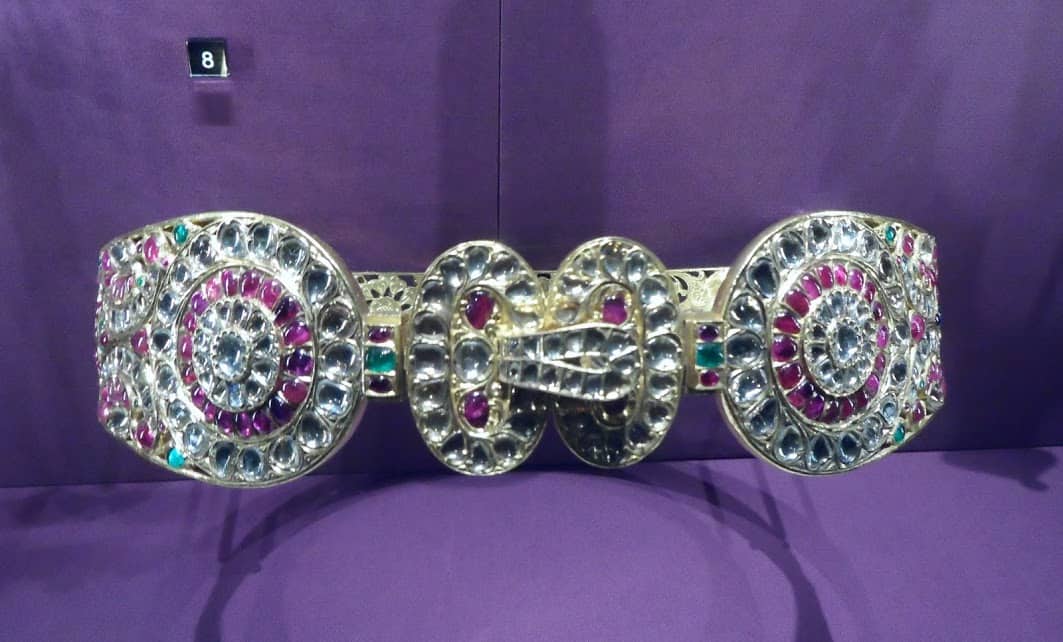In October 1875, the Prince of Wales set off on a four-month tour of the Indian Subcontinent, visiting over 21 localities, which today encompass India, Sri Lanka, Pakistan and Nepal.

The exhibition Splendours of the Subcontinent at The Queen’s Gallery, Buckingham Palace in London, tells the story of this grand tour through some of the finest Indian treasures from the Royal Collection that were presented to the Prince during his visit. This beautiful exhibition is now coupled with Four Centuries of South Asian Paintings and Manuscripts showing alongside, all in the Collection of HM The Queen.
The Queen’s Gallery, Buckingham Palace:
June 8 – October 14, 2018
These spectacular items, jewellery and plate, swords, perfume holders, a sirpech which is a turban ornament made of three large emeralds and bordered with diamonds, a gold plate which took four years to make… all these priceless pieces were given to the then Prince of Wales ‘Bertie’ on his four-month tour of the subcontinent in 1875 as part of the traditional exchange of gifts and preceding the declaration of his mother Queen Victoria being declared Empress of India.
Regarded as some of the finest works of Indian design and craftsmanship from the Royal Collection, the gifts were displayed countrywide between 1876 and 1883. By the end of 1883 the gifts had been seen by more than two and a half million people in Britain alone.
The turban ornament or sirpech was one of the first gifts that the Prince of Wales received; it was presented by Sajjan Singh the Maharana of Udaipur. The glorious emeralds sing out at the viewer. The current Custodian of Udaipur Mewar is the 76th – Arvind Singh Mewar and his royal house has been in a continuing line since AD734!
The Prince received a necklace from the Maharaja of Gwalior on behalf of his mother Queen Victoria. She chose to have it refashioned once it reached England. On a personal note one of the descendants of that very maharaja is currently the Chief Minister of Rajasthan State, Vasundara Raje (a princess of Gwalior) and she and her son hosted me at their Raj Niwas Palace in 2008 in the very rooms the then Maharaja of Dholpur had built to receive the great monarch’s son HRH Prince of Wales.
Raj Niwas palace has vast rooms and bedrooms with dressing rooms and wonderful ensuite bathrooms…. Yes, indeed complete with showers, WCs, bidets that were all decked out in the most splendid tiling which had been ordered from Jackfield in Shropshire, England, which was once the centre of the tile industry and part of the British Industrial Revolution.
In February 2008, we had been invited to spend two nights at Dholpur. We were shown into a vast bedroom that, with its wonderful tiling, gave the impression one was sleeping at the bottom of a vast Victorian swimming pool; there was a large dressing room and then the bathroom. I have included the photos to give some idea! Today the Palace at Dholpur is now a museum so we were some of the last to live in its splendour!
In the Exhibition, there is a perfume holder presented by the then Maharaja of Jaipur, and today the young maharaja has recently come of age. Gaj Singh II of Jodhpur is the current holder of the distinguished Jodhpur title.
There is a painting of his ancestor Jashwant Singh being invested with the honour the Star of India by the Prince of Wales on 1 January 1876. He too is a great custodian of his inheritance in modern Jodhpur Marwar in Rajasthan. A most beautiful double half hunter watch presented by the Maharaja of Patiala to the Prince has his own portrait on the ornamentation.
His heir and my own great grandfather were good friends and my great grandfather built the heir two mansions at Patiala and his own private railway! From southern India there is a magnificent gold service presented by the Maharaja of Mysore – it is truly stunning; the current holder of that title is a fine young man who recently married a Dungarpur princess from Rajasthan and they have just become very proud parents of a baby son.
India continues to have a wealth of riches one can view in palaces and forts and citadels and private city museums, as well as the national museums in the larger cities and towns. The people of Great Britain must have been enthralled with these treasures and the Prince of Wales ensured that they were well exhibited upon his return, thus in true royal fashion, stimulating the start of much business in all things Indian.
The trip encompassed 7,600 miles by land and 2,300 miles by sea and he met with 90 rulers. There were some other activities like tiger hunting (shikar) and I believe he even shot an elephant – it was considered a truly regal action – but thankfully, in India today no longer is that sort of deplorable trophy hunting allowed and indeed HRH Prince of Wales and HRH Prince William actively support Elephant conservation charities.
The two exhibitions open on the June 8 and will continue until October 14 2018. See my gallery of some of the exhibits seen whilst shown in Edinburgh and check out the Royal Collection’s website.
Royal Collection Trust / © Her Majesty Queen Elizabeth II 2018.
Aline Dobbie is an author of four books on India and a travel writer. She lives in Scotland but travels widely throughout the year with an annual visit to India where she was born & grew up. Aline’s earlier life was in the corporate world but now lives a rural life with emphasis on travel, gardening, cooking, and family. India, South Africa, England, Scotland, Greece and other lovely places are a constant delight to her.








